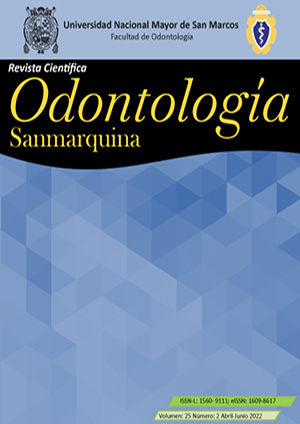Tumor lesions in the oral region: verrucous carcinoma and oral squamous cell carcinoma. A case report
DOI:
https://doi.org/10.15381/os.v25i2.22706Keywords:
Verrucous carcinoma, Oral surgery, DiagnosisAbstract
Oral squamous cell carcinoma represents a worldwide public health problem. Being the most common malignant neoplasm in the oral cavity and one of the ten most common cancers worldwide. Verrucous carcinoma is a variant of oral squamous cell carcinoma that has a high degree of local invasion and low possibility of spreading. In addition, it represents 2 to 12% of all oral carcinomas, with a 5-year survival rate. This article reports the case of a 79-year-old male patient, after performing the extra and intraoral exams, as well as the complementary ones, an increase in volume is observed in the anterior portion of the mandible, irregular crateriform, painful on palpation. Verrucous carcinoma was diagnosed involving teeth 3.3-4.3 and the surrounding mucosa in the oral cavity. The treatment consisted of complete surgical removal, without alteration or damage to the surrounding areas, with postoperative follow-up. Knowledge of this type of pathology can guide the dentist to the suspicion of different cancerous lesions, which will prevent complications and thus provide the best treatment option for affected patients.
Downloads
Downloads
Published
Issue
Section
License
Copyright (c) 2022 Carlos Fernando García Gutiérrez, Francisco Gerardo García González, Alfredo Salinas Noyola

This work is licensed under a Creative Commons Attribution 4.0 International License.
AUTHORS RETAIN THEIR RIGHTS:
a. Authors retain their trade mark rights and patent, and also on any process or procedure described in the article.
b. Authors retain their right to share, copy, distribute, perform and publicly communicate their article (eg, to place their article in an institutional repository or publish it in a book), with an acknowledgment of its initial publication in the Odontología Sanmarquina.
c. Authors retain theirs right to make a subsequent publication of their work, to use the article or any part thereof (eg a compilation of his papers, lecture notes, thesis, or a book), always indicating the source of publication (the originator of the work, journal, volume, number and date).






